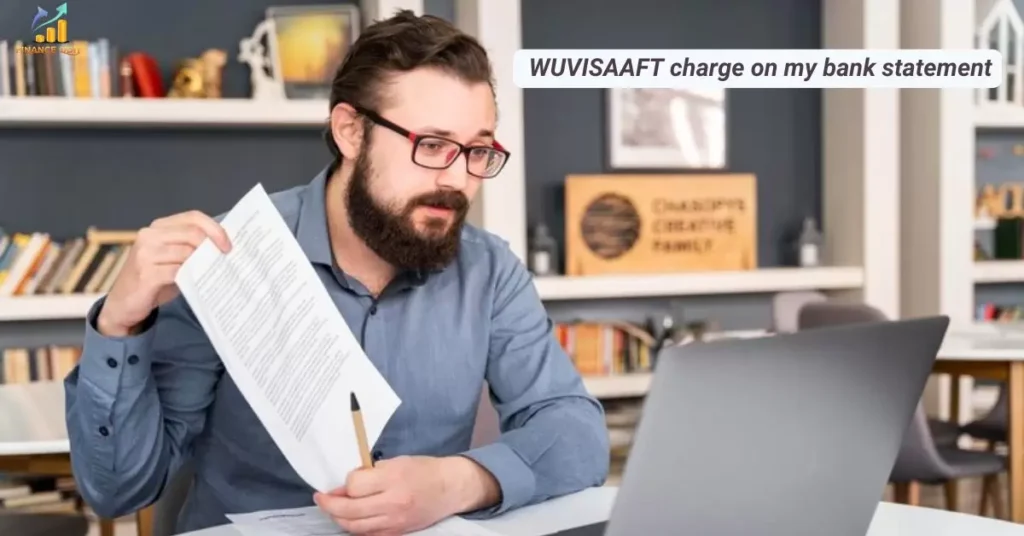Have you actually ever looked carefully at your bank statement, wondering what is this mysterious and strange charge “WUVISAAFT”? You are not alone. Many people are confused over this dubious entry wondering if it is not a hidden charge or even fraud.
In any case, calm down! Let’s dive into the world of banking jargon and international transactions to unravel this financial enigma.
Breaking Down WUVISAAFT: More Than Just a Jumble of Letters
WUVISAAFT isn’t a secret code or a typo. It’s an acronym that stands for “Western Union Visa International Service Assessment Foreign ATM Fee Transaction.” Quite a mouthful, right? Let’s break it down:
- WU: Western Union
- VISA: The global payment network
- AFT: Automated Funds Transfer
The fee usually comes when your card has been utilized for an international transaction, most commonly through money transfer services like Western Union. But, why does this happen and what impact will it have on your finances?
Common Misconceptions
Many people see “WUVISAAFT” and immediately think:
- It’s a scam
- Their account has been hacked
- It’s a new bank fee they weren’t told about
In reality, it’s a legitimate charge related to international transactions. But understanding why it appears can help you manage your finances better.
When Might You See a WUVISAAFT Charge?

You’re most likely to encounter this fee when:
- Using an ATM abroad
- Making purchases in a foreign currency
- Sending money internationally through Western Union
- Receiving funds from overseas
The frequency and amount can vary, but it’s typically a percentage of the transaction value, often around 1-3%.
| Transaction Type | Typical WUVISAAFT Charge Range |
| ATM Withdrawal | $1 – $5 + percentage |
| Foreign Purchase | 1% – 3% of transaction amount |
| Money Transfer | Varies based on amount sent |
The Western Union Connection: More Than Just Telegrams
Western Union has come a long way since its telegram days. Founded in 1851, it’s now a global leader in cross-border money transfers. But how does this relate to that charge on your statement?
Western Union partners with banks and credit card companies to facilitate international transactions. When you use their services, either directly or indirectly, you might incur fees that show up as WUVISAAFT.
“In an increasingly connected world, the ability to move money quickly and securely across borders is crucial.” – Western Union CEO
International Money Transfer Services
Western Union offers various ways to send money internationally:
- Online transfers
- In-person at WU locations
- Through partner banks
Each method might incur different fees, which is where WUVISAAFT comes into play.
Visa’s Role: The Invisible Hand in Global Transactions
Visa isn’t just a piece of plastic in your wallet. It’s a vast network that facilitates millions of transactions every day. When it comes to WUVISAAFT charges, Visa plays a crucial role:
- Processing cross-border transactions: Visa converts currencies and ensures the money gets where it needs to go.
- Assessing fees: Part of the WUVISAAFT charge goes to Visa for their services.
- Security measures: Visa implements fraud prevention measures for international transactions.
The Anatomy of an International Transaction Fee
When you make a purchase abroad or send money internationally, several players take a slice of the pie:
- Your bank
- The recipient’s bank
- Visa (or another card network)
- Currency conversion services
WUVISAAFT is essentially a bundled charge that covers various aspects of this complex process.
Read About: What Is ‘Int I Digital Charge’ on Your Bank Statement? Find Out Now!
Is a WUVISAAFT Charge Cause for Concern?

Seeing an unfamiliar charge on your statement can be alarming. But in most cases, a WUVISAAFT charge is nothing to worry about. However, it’s always wise to stay vigilant.
Legitimate vs. Suspicious Charges
Legitimate WUVISAAFT charges:
- Correspond to an international transaction you remember making
- Are for amounts that make sense given the transaction
- Appear alongside the original transaction on your statement
Suspicious signs:
- Multiple WUVISAAFT charges you don’t recognize
- Charges that don’t match any of your recent activities
- Unusually large amounts
Verifying the Charge
If you’re unsure about a WUVISAAFT charge:
- Review your recent transactions
- Check for any international purchases or ATM withdrawals
- Contact your bank for clarification
Many banks now offer real-time transaction alerts. Setting these up can help you track charges as they happen.
The Nitty-Gritty of International Transaction Fees
Understanding why banks charge for foreign transactions can help demystify that WUVISAAFT entry on your statement.
Why the Extra Cost?
- Currency conversion: Banks incur costs when converting one currency to another.
- Network fees: Visa and other networks charge for using their global infrastructure.
- Risk mitigation: International transactions carry higher fraud risks, requiring additional security measures.
Fee Breakdown
A typical international transaction fee might look like this:
- 1% Visa international service assessment
- 2% Bank’s foreign transaction fee
- Potential ATM fee if withdrawing cash
These often get bundled into that single WUVISAAFT line on your statement.
Read About: What Is ACHMA VISB Payment? A Complete Guide
Avoiding WUVISAAFT Charges: Smart Traveler Hacks
While you can’t always avoid these fees, there are ways to minimize them:
- Use credit cards with no foreign transaction fees: Many travel-oriented cards offer this perk.
- Plan ahead for currency needs: Exchanging money before you travel can sometimes be cheaper.
- Use local bank ATMs: They often have lower fees than standalone ATMs.
- Consider alternative money transfer services: Companies like TransferWise or PayPal might offer lower fees for international transfers.
Case Study: The Savvy International Shopper
Meet Sarah, a frequent international traveler. She used to rack up significant WUVISAAFT charges on her trips. Her solution?
- Got a credit card with no foreign transaction fees
- Uses a multi-currency digital wallet for smaller purchases
- Alerts her bank before traveling to avoid transaction blocks
Result: Sarah cut her international transaction fees by over 80% on her last trip!
When Things Go Wrong: Dealing with Overcharges

Despite your best efforts, you might sometimes find yourself overcharged. Here’s what to do:
- Gather evidence: Collect receipts and any correspondence related to the transaction.
- Contact your bank: Many have dedicated dispute resolution teams.
- Know your rights: In the US, the Electronic Fund Transfer Act protects consumers from certain unauthorized charges.
“Banks are required to investigate and resolve disputes promptly, typically within 10 business days.” – Consumer Financial Protection Bureau
The Future of International Transactions: What’s on the Horizon?
The world of international finance is evolving rapidly. Here’s what we might see in the coming years:
- Blockchain technology: Could make cross-border transactions faster and cheaper.
- Digital currencies: Central bank digital currencies (CBDCs) might change how we handle international money.
- Stricter regulations: Governments are looking to make international fees more transparent.
These changes could mean the end of WUVISAAFT as we know it, replaced by more transparent and possibly lower fees.
What should I do if I don’t recognize the WUVISAAFT charge on my bank statement?
If you spot a WUVISAAFT charge you don’t recognize, don’t panic. First, take a close look at your recent transactions. This fee frequently appears after making purchases online internationally or using your cards overseas. If this does not sound familiar, call up the bank contact center. They will assist you in understanding what is happening with your account.

Do not be afraid to ask questions because the money is yours. If it was improper they can help you dispute it, banks are great at those things. Monitor your statement closely, as it is a good idea to identify any unusual charges early.
Frequently Asked Questions
How can I tell if a WUVISAAFT charge on my statement is legitimate?
A legitimate WUVISAAFT charge typically corresponds to an international transaction you’ve made.It is required to show up with the corresponding purchase and be of a sensible worth (often 1 to 3 percent of it). If you have any confusion, look at your recent transactions and ask your bank for confirmation.
Are there any banks that don’t charge WUVISAAFT fees?
While most banks charge some form of foreign transaction fee, some offer accounts or credit cards specifically designed for international use. These may waive or reduce WUVISAAFT charges. Research “no foreign transaction fee” credit cards or global bank accounts to find options that might suit your needs.
Can I dispute a WUVISAAFT charge if I think it’s incorrect?
Yes, you can definitely dispute a WUVISAAFT charge if you think it’s wrong. Just call your bank, explain why you believe the charge is incorrect, and they’ll look into it for you. Banks have to check these disputes quickly, usually within 10 days, and if they find a mistake, they’ll fix it and give you your money back.
Final Thoughts
Understanding that WUVISAAFT charge is just one piece of the puzzle in managing your international finances. Here’s what to remember:
- WUVISAAFT is usually a legitimate charge related to international transactions.
- It covers various fees from different entities involved in processing your transaction.
- You can often minimize these charges with the right financial tools and planning.
- Keep an eye on your statements all the time and do not refrain from questioning any unknown charges.
When going through the world of international transactions, being informed and proactive gives you confidence. Whether you travel often, shop online all the time or send money abroad once in a while, knowing the cost of these fees helps you manage your finances effectively.
Have you encountered a WUVISAAFT charge recently? How did you handle it? Share your experiences and tips in the comments below!

I am a professional finance blogger who simplifies complex financial topics, offering practical advice on personal finance and market trends. My blog helps readers make informed financial decisions with clear, accurate insights.











